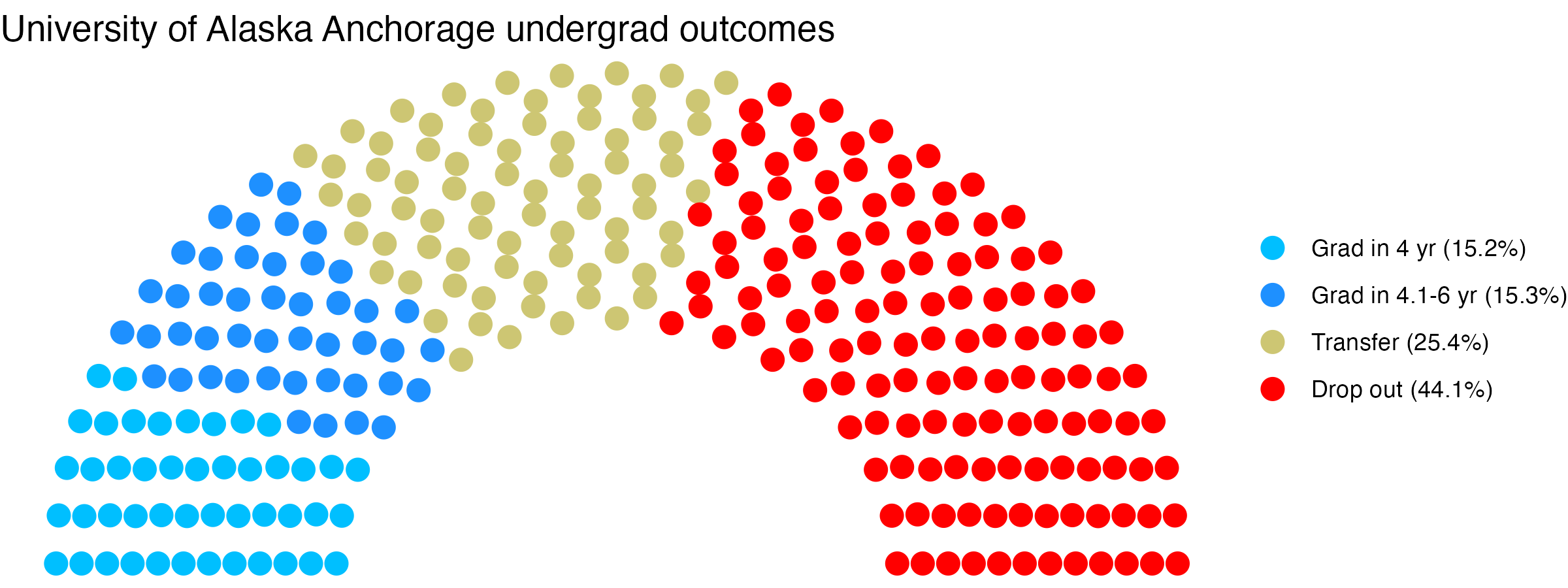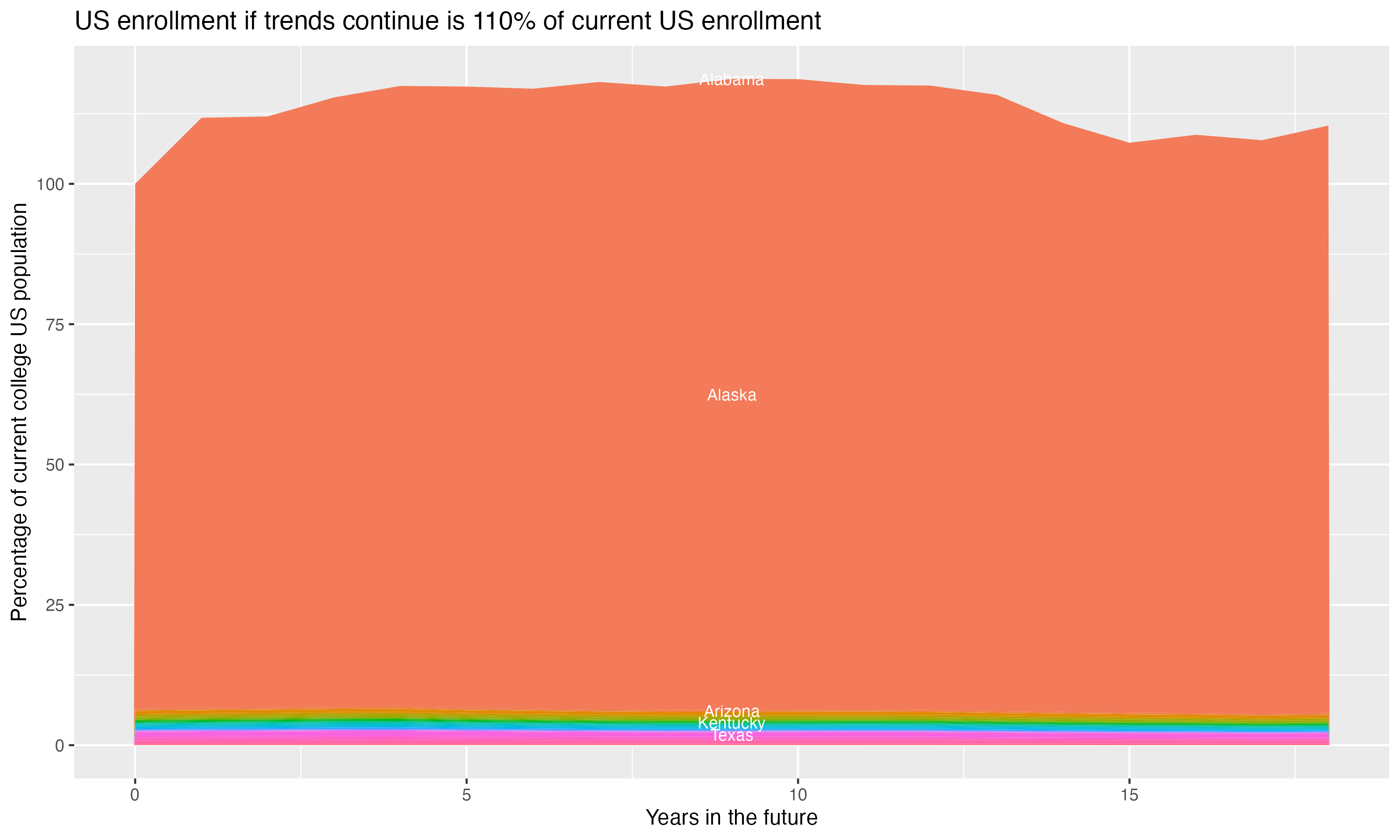University of Alaska Anchorage
University of Alaska Anchorage is located in Anchorage, Alaska. It is a public, 4-year or above institution.
From Wikipedia: The University of Alaska Anchorage (UAA) is a public university in Anchorage, Alaska, United States. UAA also administers four community campuses spread across Southcentral Alaska: Kenai Peninsula College, Kodiak College, Matanuska–Susitna College, and Prince William Sound College. Between the community campuses and the main Anchorage campus, roughly 15,000 undergraduate, graduate, and professional students are currently enrolled at UAA. It is Alaska’s largest institution of higher learning and the largest university in the University of Alaska System. UAA’s main campus is located approximately four miles (6.4 km) southeast of its downtown area in the University-Medical District, adjacent to the Alaska Native Medical Center, Alaska Pacific University and Providence Alaska Medical Center. UAA is divided into five instructional and research units at the Anchorage campus: the College of Arts and Sciences, College of Business and Public Policy, the Community and Technical College, College of Engineering, and the College of Health. UAA offers master’s degrees and graduate certificates in select programs, and the ability to complete certain PhD programs through cooperating universities through its Graduate Division. UAA is accredited by the Northwest Commission on Colleges and Universities. In 2019, UAA’s School of Education lost Initial Preparation specialized accreditation from the Council for the Accreditation of Educator Preparation (CAEP). The school’s Advanced Preparation program successfully renewed CAEP-accreditation during annual review in 2021. As of May 2022, the School of Education has provisional approval from the Alaska Department of Education & Early Development to offer a bachelor’s degree in early childhood education that leads to licensure.
Overview of institution
This, and the rest of the page, use info from the most recent year available, generally 2024.
Institution kind: Master’s Colleges & Universities: Larger Programs
Undergrad program: Professions plus arts & sciences, some graduate coexistence
Graduate program: Research Doctoral: Humanities/social sciences-dominant
Enrollment profile: Very high undergraduate (see more details below)
Average net price for undergrads on financial aid: $13,931 . This is 80% the average cost of Harvard.
Actual price for your family: Go here to see what your family may be asked to pay. It can be MUCH lower than the average price but also higher for some.
Size and setting: Four-year, medium, primarily nonresidential
In state percentage: 92% of first year students come from Alaska
In US percentage: 98% of first year students come from the US
Graduation rate (within 6 years) for students seeking a Bachelors: 30.5% (this is what is usually reported as “graduation rate”)
Graduation rate (within 4 years) for students seeking a Bachelors: 15.2%
Percent of students seeking a Bachelors who transfer out of this institution: 25.4%
Student to tenure-stream faculty ratio: 14.2 (undergrads to tenure-stream faculty) [Tenure explained]
Student to faculty ratio: 9.8 (undergrads to all faculty)
Degrees offered: Certificate of less than 1 year, Certificate of at least 12 weeks but less than 1 year, Certificate of at least 1 year but less than 2 years, Associate’s degree, Bachelor’s degree, Postbaccalaureate certificate, Master’s degree, Post master’s certificate, Doctor’s degree: research scholarship, Doctor’s degree: professional practice
Schedule: Semester
Institution provides on campus housing: Yes
Dorm capacity: There are enough dorm beds for 996 students
Freshmen required to live on campus: No
Advanced placement (AP) credits used: Yes
Disabilities: 3 percent or less of undergrads are registered as having disabilities.
Undergrad outcomes
This plot shows the outcomes for first time, full time undergraduates seeking Bachelor’s degrees (if the data are available).

Map
Comparisons
The sections below show this institution compared with others. The ones listed are ones it has identified as peers, who consider themselves peers, and/or who the federal government considers peers. If a comparison school has the same value as the focal school, its cell is grayed out. In fields where there is a common view that higher (or lower) values are better, the best values are in blue, the worst values are in red. If there isn’t a sense of a particular value being better, values are shown in varying shades of green. Arrows show where there is a signficant trend over time for a school. You can swipe across the table to see more of it; the focal school column is always visible.
- University of Alaska Anchorage lists these schools as ones to compare itself within federal IPEDS data, and they do the same back: Utah Valley University, College of Staten Island CUNY, Purdue University Fort Wayne, Florida Gulf Coast University
- University of Alaska Anchorage compares itself to these institutions, but not vice versa: Arizona State University Digital Immersion, Weber State University, University of North Georgia, Idaho State University, University of Alaska Fairbanks, The University of Texas Rio Grande Valley, Utah Tech University, University of West Florida, McNeese State University, University of Alabama at Birmingham, Texas Southmost College, Arkansas State University, Boise State University, University of Alaska Southeast, Eastern New Mexico University-Main Campus, Western Kentucky University, Youngstown State University, University of Arkansas at Little Rock, Ferris State University, New Mexico Highlands University, Southeastern Oklahoma State University, Colorado Mesa University, Northwestern State University of Louisiana, Troy University, Arkansas Tech University, Northern Kentucky University, Lamar University, Texas Woman’s University, East Texas A&M University
- These institutions compare themselves to University of Alaska Anchorage, but not vice versa: Embry-Riddle Aeronautical University-Daytona Beach, College of Charleston, Sam Houston State University, Embry-Riddle Aeronautical University-Prescott, California State University-Northridge, Missouri State University-Springfield, Central Connecticut State University, West Virginia University Institute of Technology, State University of New York at Oswego, Rutgers University-Camden, Alaska Pacific University
Enrollment

General
Teaching
Tenure track faculty are those who are eligible for tenure. This includes both pre-tenure and tenured faculty. Once faculty get tenure, they are (generally) protected from being fired for intellectual reasons, helping to ensure their freedom in teaching and research. They can still lose their positions for misconduct, financial problems, not fulfilling their duties, or other reasons.
Non-tenure track faculty are not eligible for tenure. Some are hired one semester at a time, some have multi-year contracts. They typically have a higher teaching load than tenure track faculty, leaving less time for research or other creative endeavors. They are also easier to fire than tenured faculty. Sometimes they are external experts (a noted musician, a former senator) who are hired to teach some classes without the expected permanence of a tenure-track position.
Note that this chart uses US federal demographic data: it only has two genders and a specified set of ethnicities and races.
Having a low student to faculty ratio is considered a good thing by many, as it can mean more individual attention.
Geography
This has information on the location of the institution. See the about page for more information on what the metrics are and how they are calculated.
Financial Aid
Graduation
Note these are bachelors graduation rates in six years, not four (this is standard). Sample sizes can be small for some demographic groups with few individuals in a school, leading to large year-to-year fluctuations and often extreme values for those groups (if there are two individuals in the class with a given identity, the possible graduation rates are 0%, 50%, or 100% depending on whether zero, one, or both students graduate within six years).
Library
Libraries are changing rapidly. Note that how institutions count digital collections may vary.
Diversity
The US Census Bureau has a diversity index that goes from 0 to 1. In their words, “A 0-value indicates that everyone in the population has the same racial and ethnic characteristics. A value close to 1 indicates that everyone in the population has different racial and ethnic characteristics.” This uses their formula, but with the resolution available for the federal IPEDS data (which does not separate for a given demographic group whether members identify as Hispanic or not). This metric is about heterogeneity within the population, not the proportion of the population that comes from historically excluded groups.
Following the practice of the census, the index is multiplied by 100 to give the percentage probability a random pair of individuals will have a different background. Most institutions argue that diversity is a benefit, so by default a higher number is listed as better, but there may be cases where this measure does not reflect the mission of a college (for example, 70% of the students at a tribal college or university may be American Indian: that could be low-scoring by this metric but should not be read as “bad” given the institution’s mission).
These numbers are based on the most recent year available, generally 2024, which predates effects of the US Supreme Court’s striking down of affirmative action. This has often changed, sometimes dramatically, the incoming student demographics at some institutions.
Overall diversity
Freshman profile
Demographic data for first time degree-seeking students. Note that this uses US federal demographic data: it only has two genders and a specified set of ethnicities and races.
Freshman geography
Test scores
SAT scores
ACT scores
Majors
This presents information on the number of majors and the median earnings one and five years after graduation for people who got a degree from this institution in that field. The earnings are for those who are working and not enrolled in further education. The earnings data (from the federal college scorecard) also has information on earnings for those categorized as ‘MALE’ and ‘NOMALE’ – for readability, these are recategorized here as “Men” and “Women”, respectively, which adopts the gender binary used in other federal data. “W/M earnings ratio” is the median earnings of women divided by men, as a percentage.
Bachelors
Masters
Doctorate
Certificate
Associates
Demographic cliff
There is a concern that giving changing US demographics, the number of students in the age groups who most commonly attend four year colleges will drop off, decreasing overall enrollment. This is often referred to as the “demographic cliff”, and it can be a concern for colleges concerned about the risk of falling enrollment. For this section, the analysis uses US census data on the number of people in each state by age, and the proportion of students that come from each state for this particular college, to crudely model what will happen if everything remains constant except the demographic change in the population of 18 year olds in each year – it does not account for things like the college increasing its admission rate, attracting more students from states without the same demographic changes or from other countries, or changes in the proportion of students who go to college.
